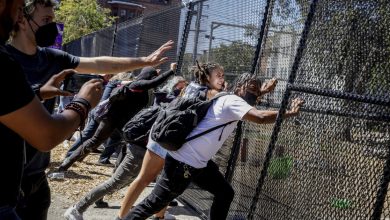Protests Over Sexual Violence Rocked Campuses Last Fall. So What’s Changed?

One year ago, a certain kind of student activism was spreading across college campuses.
Reports of an alleged sexual assault would rally hundreds — sometimes thousands — of students. A social-media storm would follow. Instagram accounts would call on colleges to address allegations of mishandling sexual-assault cases. Protests on one campus would continue for a few days and die down, but then another protest would crop up elsewhere.
At Indiana University at Bloomington, students were outraged over 35 sexual-assault allegations reported between the start of the fall semester and Thanksgiving, said Madison Butler, who’s now a senior. After a pandemic-disrupted 2020 with fewer reports, the number came as a shock, said Butler, a co-director of Title IX and sexual-violence prevention for Indiana’s student government.
“For those to be the reported numbers,” she said, “you can only imagine how much higher the actual number of incidents are.”
Colleges that saw protests last year — including ones that drew national attention at the University of Nebraska at Lincoln, the University of Kansas, and the University of Massachusetts at Amherst — have taken various approaches in response: suspending fraternities that faced sexual-assault allegations, reinforcing prevention training for students, establishing student advisory boards on Title IX, or opening investigations.
But if the 2021 protests demonstrated anything, it was that even one reported or rumored incident of sexual assault was enough to call students to action. That has continued this fall.
Earlier this month, at Central Connecticut State University, a sexual-assault allegation that stemmed from a TikTok video prompted more than a hundred students to protest. In the video, a student films herself as she is asked by another person (who is offscreen) what she would like changed on her campus. In response, she says she “would like to see less people in [student leadership] positions accused of rape, such as you.” The video has been viewed nearly 200,000 times.
Bria Stanley, a junior at Central Connecticut State, helped organize the protest. “The same conversation just keeps happening because there’s no real action being taken by these universities. It’s just a lot of talk,” Stanley said. “We’re not going to shut up and wait for things to happen.”
In the meantime, many colleges have sent campus safety alerts warning of recently reported sexual assaults, which have also reignited students’ concerns.
The demands from student activists this semester largely remain the same as they were last year. What has emerged from the student movement against sexual violence are several recurring debates over college and university action — and inaction.
“It’s so weird to think that it’s been a year since that experience,” said Thalia Charles, a policy organizer with Know Your IX, a victim-advocacy group on Title IX, and a recent Lafayette College graduate, referring to last fall’s protests. “Despite all of these massive protests, there’s still inaction from schools in addressing sexual violence.”
Activism as a ‘Part-Time Job’
Activism against sexual violence has become a deeply ingrained part of the college experience, for students and administrators alike.
From May 2021 to August 2022, there were 309 protests related to sexual violence in schools, 174 of which were focused on colleges and universities. That’s according to data recorded by the Crowd Counting Consortium, which is managed by researchers at the Harvard Kennedy School’s Nonviolent Action Lab.
At first glance, it appeared that sexual-assault cases, or at least outcries against such allegations, were particularly numerous last fall. But grass-roots movements against campus sexual violence have been growing for years.
Students have taken on leadership roles to prevent sexual violence, whether in student government or advocacy organizations. They’ve educated themselves on the “red zone,” the period between the start of the academic year and Thanksgiving, when most sexual assaults take place; the ever-shifting intricacies of Title IX compliance; and the nuances of investigations and legal parameters.
Students are doing this work because they feel it’s urgent, Charles said.
“It’s just really unfortunate that students have to protest at all,” Charles said. “Students should be in their classrooms learning about history and literature and mathematics, and not having to petition their schools to move them out of a residence hall so they can get away from their rapist.”
There comes a point, according to 2020 research on student activism against campus sexual violence in the United States and Britain, when activism becomes a “part-time job.” Students hold the power to put pressure on their institutions, researchers at Rutgers University at New Brunswick, Wichita State University, and the University of the West of England wrote.
But activism can also have “a detrimental impact upon student experience where involvement in student activism can become consuming, leading to issues with attainment and progression, contributing to being ostracized by peers, or to campus leaders viewing activists as troublesome to campus life,” the authors wrote.
The fight gets passed down to new classes of students, adding to the complexity of working for permanent change.
“Different generations of students confront it and protest against it,” said Sarah Jane Brubaker, a Virginia Commonwealth University professor in the L. Douglas Wilder School of Government and Public Affairs who has researched sexual and domestic violence. “But it’s been decades in the works.”
To Brubaker, preventing sexual violence needs to go beyond student activism. Rather, “major change in the campus culture and climate” must come from college and university administrators, she said.
“You have to see really powerful, not just statements, but action from upper administration and leadership,” Brubaker said. “We see so much lip service about ‘culture of care’ and all these things, and I have yet to see any concrete example of what that looks like.”
The Education Department’s widely anticipated changes in Title IX enforcement have also spurred students and organizers in grass-roots organizations, including Know Your IX and End Rape on Campus, to draft letters and comments to the Biden administration. In her role as co-director of Title IX for Indiana University’s student government, Butler also anticipates working with administrators next spring to rewrite the campus’s Title IX policies if the new federal rules go into effect. The Biden proposals would, in many respects, reverse policies adopted by the Trump administration.
Brett A. Sokolow, president of the Association of Title IX Administrators and a risk-management consultant who works with colleges, said the constant policy shifts across presidential administrations are ultimately impeding student victims’ willingness to report.
“We’re still at a point where probably less than a tenth of the people who come through our door with eligible complaints wind up actually filing and pursuing them,” Sokolow said. “That’s a terrible gap between what we could be doing to help and what we are actually doing.”
A Persistent ‘Disconnect’
While many students are adamant that colleges are falling short, institutions often face challenges in responding, too, Sokolow said. He described “the disconnect between how many people experience the behavior and how many people report that behavior — because those are very different things,” he said.
In some cases, colleges have been responding to activism about rumored incidents. At UMass-Amherst last year, protests responding to an anonymous assault accusation on social media turned destructive, with reports of people shattering windows and flipping cars. But no formal complaint about the alleged assault was ever filed, a university spokesperson said.
After the protests, UMass created a training program on sexual-misconduct awareness and prevention for fraternity and sorority members, the spokesperson said, and formed a student advisory board on Title IX “to provide guidance regarding policies, procedures, and education efforts related to sexual misconduct.”
Meanwhile, Nebraska — where students protested against a fraternity for three days last year — started offering new workshops to professors, staff members, and graduate students who could receive sexual-misconduct disclosures. A peer-education program for undergraduates is set to start in October.
Leslie Reed, a Nebraska spokesperson, said in a written statement to The Chronicle that the university had suspended Phi Gamma Delta, or Fiji, the fraternity where an alleged sexual assault took place last fall, until the fall of 2027 for “alcohol-related and other violations.” The fraternity had just emerged from a three-year suspension in 2020.
The university investigated the alleged assault, but “no charges have been filed,” and the university’s police department “considers the investigation closed,” the statement says.
At Kansas, where thousands of students protested a fraternity over sexual-assault allegations, The University Daily Kansan reported in the spring that the university had done little to respond. A Kansas spokesperson told The Chronicle that officials had opened an investigation, but declined to provide more information. In response to student concerns, the university held meetings with campus groups throughout the year, as well as a town-hall forum that drew a dozen students.
For now, activism at those three institutions appears to have died down.
But from what Charles, the Know Your IX organizer, has heard from students across the country, campus environments haven’t improved much. Over the past year, she’s heard stories during listening sessions of colleges that failed to provide academic support and housing accommodations for survivors.
Some students also said their Title IX cases were taking years. One student described her experience reporting her assault to her college in the fall of her freshman year, Charles said. Now a senior, the student still hasn’t gotten a resolution.
“This lack of response is going to have a silencing impact on reporting,” Charles said, “because it sends this message to survivors that even if you report, your school isn’t going to provide you with the supportive measures and resources necessary for you to stay in school.”
At Central Connecticut State, Stanley said students are calling on the university to increase transparency about reports of sexual violence, and to bridge a “disconnect” between administrators and students. Stanley also said students had been sharing stories about classmates who reported incidents and then were kept in classes with the people they had accused.
“People have been afraid to speak out about sexual assault on college campuses, considering a lot of people are in leadership positions on campus or have other involvements and are afraid to be seen as troublemakers,” Stanley said. “But I think at this point, everyone was just kind of fed up, because nothing has really been done, and not even just on our campus.”
In response to a request for comment, a Central Connecticut State spokesperson provided the email that the university’s president, Zulma R. Toro, sent to students several hours after the TikTok video was posted. The email states that no formal complaint had been filed, but that the president had commissioned an outside investigation of the allegation.
“The investigation is ongoing, and the president will update the campus community when she receives the investigation report,” the spokesperson said.
Kenyora Parham, executive director of End Rape on Campus, said it’s ultimately the colleges’ duty to make the necessary changes.
“We need our schools, our campus administrators,” Parham said, “to truly step up and put an end to this, to hold perpetrators accountable, and to hold themselves accountable for living up to what Title IX should be.”
Source link






